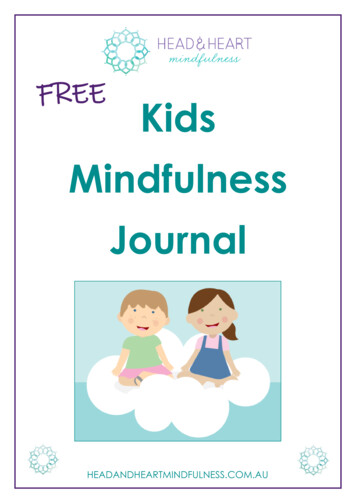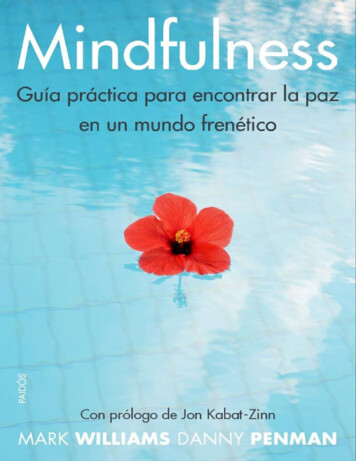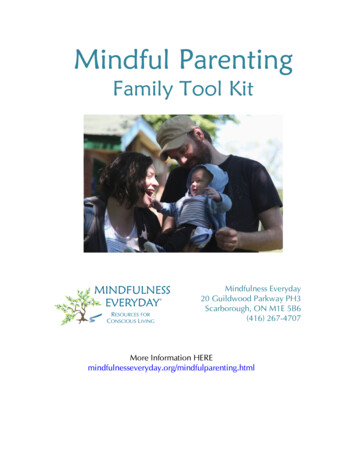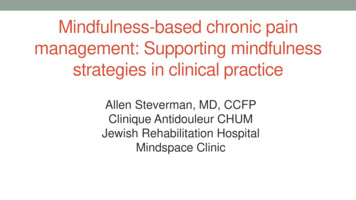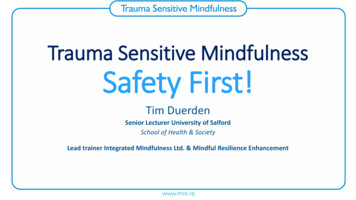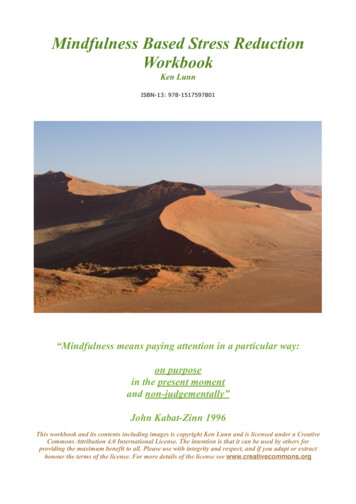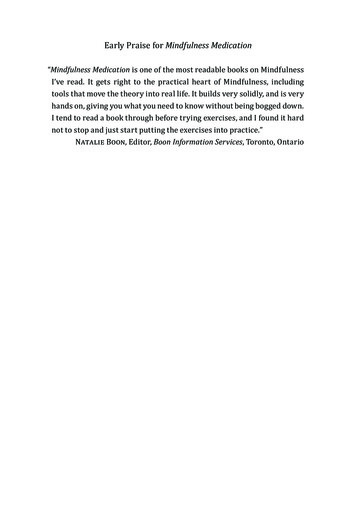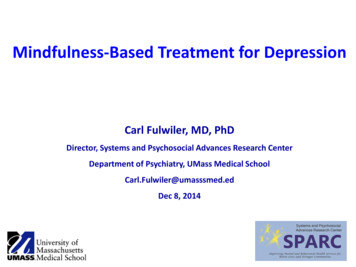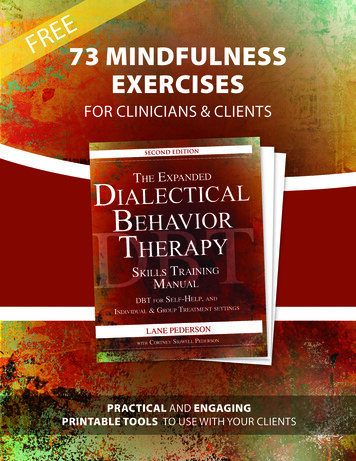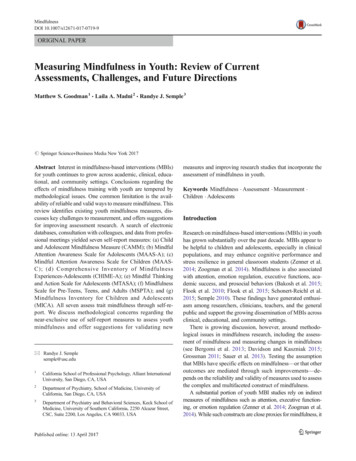
Transcription
MindfulnessDOI 10.1007/s12671-017-0719-9ORIGINAL PAPERMeasuring Mindfulness in Youth: Review of CurrentAssessments, Challenges, and Future DirectionsMatthew S. Goodman 1 & Laila A. Madni 2 & Randye J. Semple 3# Springer Science Business Media New York 2017Abstract Interest in mindfulness-based interventions (MBIs)for youth continues to grow across academic, clinical, educational, and community settings. Conclusions regarding theeffects of mindfulness training with youth are tempered bymethodological issues. One common limitation is the availability of reliable and valid ways to measure mindfulness. Thisreview identifies existing youth mindfulness measures, discusses key challenges to measurement, and offers suggestionsfor improving assessment research. A search of electronicdatabases, consultation with colleagues, and data from professional meetings yielded seven self-report measures: (a) Childand Adolescent Mindfulness Measure (CAMM); (b) MindfulAttention Awareness Scale for Adolescents (MAAS-A); (c)Mindful Attention Awareness Scale for Children (MAASC); (d) Comprehensive Inventory of MindfulnessExperiences-Adolescents (CHIME-A); (e) Mindful Thinkingand Action Scale for Adolescents (MTASA); (f) MindfulnessScale for Pre-Teens, Teens, and Adults (MSPTA); and (g)Mindfulness Inventory for Children and Adolescents(MICA). All seven assess trait mindfulness through self-report. We discuss methodological concerns regarding thenear-exclusive use of self-report measures to assess youthmindfulness and offer suggestions for validating new* Randye J. Semplesemple@usc.edu1California School of Professional Psychology, Alliant InternationalUniversity, San Diego, CA, USA2Department of Psychiatry, School of Medicine, University ofCalifornia, San Diego, CA, USA3Department of Psychiatry and Behavioral Sciences, Keck School ofMedicine, University of Southern California, 2250 Alcazar Street,CSC, Suite 2200, Los Angeles, CA 90033, USAmeasures and improving research studies that incorporate theassessment of mindfulness in youth.Keywords Mindfulness . Assessment . Measurement .Children . AdolescentsIntroductionResearch on mindfulness-based interventions (MBIs) in youthhas grown substantially over the past decade. MBIs appear tobe helpful to children and adolescents, especially in clinicalpopulations, and may enhance cognitive performance andstress resilience in general classroom students (Zenner et al.2014; Zoogman et al. 2014). Mindfulness is also associatedwith attention, emotion regulation, executive functions, academic success, and prosocial behaviors (Bakosh et al. 2015;Flook et al. 2010; Flook et al. 2015; Schonert-Reichl et al.2015; Semple 2010). These findings have generated enthusiasm among researchers, clinicians, teachers, and the generalpublic and support the growing dissemination of MBIs acrossclinical, educational, and community settings.There is growing discussion, however, around methodological issues in mindfulness research, including the assessment of mindfulness and measuring changes in mindfulness(see Bergomi et al. 2013; Davidson and Kaszniak 2015;Grossman 2011; Sauer et al. 2013). Testing the assumptionthat MBIs have specific effects on mindfulness—or that otheroutcomes are mediated through such improvements—depends on the reliability and validity of measures used to assessthe complex and multifaceted construct of mindfulness.A substantial portion of youth MBI studies rely on indirectmeasures of mindfulness such as attention, executive functioning, or emotion regulation (Zenner et al. 2014; Zoogman et al.2014). While such constructs are close proxies for mindfulness, it
Mindfulnessis important to develop measures that sufficiently differentiatemindfulness from other related outcomes; without this, there exists a critical gap in concluding that youth MBIs effect changethrough the mechanisms they are hypothesized to operatethrough. Youth MBI studies that directly assess mindfulness arebeginning to grow as child and adolescent mindfulness measuresbecome more available, those of which are reviewed in thisarticle. Still, the direct measurement of mindfulness in youth isfaced with a number of conceptual, methodological, developmental, and cultural challenges.The first challenge in measuring mindfulness may be definingwhat it is. Scholars have noted the difficulties of translating theBuddhist concept of sati (in the Pali language) into western psychology (Bodhi 2011; Dreyfus 2011; Grossman and Van Dam2011). One challenge is that western psychology attempts tooperationalize a concept that derives from a phenomenologicalunderstanding of direct experience, embedded within a nonwestern cultural and philosophical framework (Grossman2011). Mindfulness is often defined as present-moment awareness—either focused attention or open monitoring—combinedwith an attitude of nonjudgment, curiosity, and kindness (Bishopet al. 2004; Kabat-Zinn 1994; Lutz et al. 2008). Associated characteristics include metacognitive awareness, emotional equanimity, skillful decision-making, and acting with compassion(Nanamoli and Bodhi 2001; Teasdale et al. 2002; Walsh 1996).These aspects of mindfulness are theoretically interrelatedand difficult to isolate. Measures that exclusively examinepresent-focused attention, for example, do not assess the entirety of this multifaceted construct (see discussion byGrossman 2011). Moreover, since different mindfulnessbased practices (e.g., meditation vs yoga) may develop different components of mindfulness (e.g., concentration vs bodyawareness), narrowly defined measures are likely to be differentially sensitive to different mindfulness practices. Assessingmindfulness as a global construct, although easier to do,makes it difficult to ascertain the particular mechanisms ofchange associated with mindfulness practices. Single-factormeasurements of mindfulness make it difficult to understandwhat mindfulness practices actually do and how they do it(Holzel et al. 2011).Unraveling the nuanced mechanisms of change is especially relevant in research with youth, where definitions and applications of mindfulness have largely been borrowed fromthe adult literature without a complete understanding of howmindfulness emerges within a developmental neurocognitiveframework. For example, abstract reasoning, which may precede the ability to focus attention and Bobserve thoughts andemotions with metacognitive awareness, relies on prefrontaland fronto-limbic networks that are not fully developed untilearly adulthood (Gogtay et al. 2004). Thus, it may be beneficial to use multifactorial assessment approaches to help clarifyhow different aspects of mindfulness are cultivated acrossdifferent developmental stages.The distinction between state and trait mindfulness offersanother challenge to the measurement of mindfulness. Traitmindfulness refers to a stable, dispositional quality, while statemindfulness refers to the capacity to cultivate a particular stateof mind during meditative practice. The operationalizeddefinition of mindfulness and existing youth assessmentsfavor the assessment of trait mindfulness. Thompson andWaltz (2007) suggested that there may be little relationshipbetween state and trait mindfulness. While dispositional ortrait mindfulness is seemingly easier to measure (i.e., throughself- or observer-reported behaviors), it may be less informative about an individual’s ability to cultivate a state of mindfulawareness—the skill explicitly targeted in most MBIs.Furthermore, dispositional mindfulness is likely to be lessaffected by short-term MBIs.Many have discussed problems associated with measuringmindfulness by self-report (see Bergomi et al. 2013;Grossman and Van Dam 2011; Grossman 2011; Sauer et al.2013). Biases in self-perception limit the reliability of all selfreport measures used in behavioral research (Baumeister et al.2007). Self-report bias may be especially problematic in mindfulness research because those with less mindfulness trainingmay have less insight into the nature of their own minds andbe less likely to report accurately. Alternatively, experiencedpractitioners may see their thoughts and behaviors more clearly and subsequently self-report less mindfulness (seeGrossman 2011). As an individual cultivates mindfulness, heor she will be more likely to notice that their Bmind haswandered or that they are Bjudging. Consequently, changesin mindfulness change not only the reliability of self-reportover time, but may actually reverse expected outcomes. Thisphenomenon might also be due to differential item understanding, inadequate content validity, or whether the item isworded positively or negatively. Van Dam et al. (2009) foundthat meditators and nonmeditators with similar overall levelsof Bmindfulness endorsed items differently depending onwhether they were negatively or positively worded. This finding also suggests that interpretation of items is influenced bymeditative experience. Self-report is also subject to the effectsof social desirability and demand characteristics. By the end ofa mindfulness training program, participants are well aware ofhow they Bshould be acting and may well respond to questions so as to be a Bgood participant (Nichols and Maner2008). Similarly, those who have made significant efforts toBbe mindful may respond with the desired outcome, ratherthan the actual outcome. Finally, the wording used in mindfulness questionnaires is consistent with that used in mindfulness programs (e.g., Bnonjudgment, Bpaying attention ),which provides clues to the expected responses.Culture, environment, and developmental level can furtherinfluence the interpretation of questionnaire items. Forexample, Christopher et al. (2009) found that while ThaiTheravāda Buddhist monks scored higher than American
Mindfulnesscollege students on certain subscales of the KentuckyInventory of Mindfulness (KIMS; Baer et al. 2004) andMindful Attention Awareness Scale (MAAS; Brown andRyan 2003)—both measures of trait mindfulness—Americancollege students scored higher than Buddhist monks on othersubscales. Leigh et al. (2005) found a positive associationbetween trait mindfulness and binge drinking, which the authors suggested may be due to increased awareness of bodysensations in this population. It is possible that youth withother physically focused anxieties or trauma might respondsimilarly to trait measures of mindfulness. Youth of differentages or cognitive abilities may also interpret and endorse itemsdifferently.Finally, the assessment of mindfulness needs to take intoaccount broader cultural and contextual factors. The meaningsof mindfulness, meditative practices, reasons for practicing,and expected outcomes have continuously changed acrosscountries, cultures, and time. Many current practices and assessments of mindfulness, however, are not conceptualizedwithin a biopsychosocial model or framed within a religious,spiritual, or cultural context (Lavelle 2016). With increasingappreciation for the complexity of what mindfulness is, weobserve that even within the USA, for example, mindfulnessis learned and may look markedly different in individuals ofdifferent ages, genders, ethnicities, or socio-economic strata.Mindfulness may look different within microsystems (e.g., afamily, school, or religious community), across mesosystems(e.g., different teachers within a school), exosystems (e.g.,educational systems), and macrosystems (e.g., broad culturalvalues). The assessment of mindfulness needs to progressalongside our evolving understanding of mindfulness as it fitsinto contemporary cultures.This review examines existing measures of mindfulness forchildren and adolescents. Conceptual foundations, psychometric properties, and the intended use of each measure aredescribed. Strengths and limitations are discussed for eachmeasure. Studies providing validation and support for eachmeasure are systematically included; however, interventionstudies that utilized the reviewed measures are not systematically included and are rather cited as relevant. Finally, weconsider ways to potentially improve self-report instrumentsand offer suggestions to strengthen future mindfulness studiesby including a more comprehensive assessment of outcomesfor youth.MethodSearch StrategyElectronic databases (PsycINFO, PUBMED, and GoogleScholar)were searched up through June 2016 using combinations of thefollowing terms: mindfulness, meditation, measure, assessment,youth, child/children, and adolescent/adolescence. Reference listsin relevant articles were manually reviewed. Information fromcolleagues and data from professional meetings were also sourced.Selection CriteriaSelf-report instruments were selected if their primary purposewas the assessment of mindfulness in youth (up to 18 yearsold). Assessments that did not specifically measure mindfulness were excluded (e.g., those that evaluated aspects of attention, executive function, emotional awareness, emotionself-regulation, compassion, prosocial behaviors, or broad indices of stress or resilience).ResultsSeven self-report measures were identified. Table 1 lists theage range, number of items, time to complete, and reliabilityof each measure, along with a summary of positively andnegatively correlated constructs. Four measures were locatedthrough electronic database searches (MAAS-A; Brown et al.2011; CAMM; Greco et al. 2011; CHIME-A; Johnson et al.2017; MAAS-C; Lawlor et al. 2014). Three instruments wereidentified through manual review of reference lists of relevantarticles (MTASA: West et al. 2005), personal communicationwith a colleague (MICA; Briere 2011), and data presented at aprofessional conference (MSPTA; Droutman 2015).Child and Adolescent Mindfulness Measure The CAMM isa 10-item, self-report measure of Bpresent-moment awareness,and nonjudgmental, nonavoidant responses to thoughts andfeelings in children and adolescents age 10 to 17 (CAMM;Greco et al. 2011, p. 610). Respondents rate how often eachitem is true for them using a 5-point scale (0 never true;4 always true). All 10 items are negatively worded andreversed-scored, so that higher scores indicate greater mindfulness. Items on the CAMM were adapted from the KentuckyInventory of Mindfulness Skills (KIMS; Baer et al. 2004), anadult self-report measure that is based on conceptualizationsof mindfulness from contemporary interventions such asMindfulness-Based Stress Reduction (MBSR; Kabat-Zinn1982), Dialectical Behavior Therapy (DBT; Linehan 1993),and Mindfulness-Based Cognitive Therapy (Segal et al.2002) and is compatible with conceptualizations of Buddhistteachers (Goldstein and Kornfield 1976; Rosenberg 1998).Items were developed based on three of the four facets ofmindfulness found on the KIMS: observing, acting withawareness, and accepting without judgment. The fourth itemof the KIMS (describing) was not adapted for the CAMM dueto the premature and highly variable cognitive and verbalcapabilities of children (Greco et al. 2011).
15253214–189–139–198–18MAAS-CCHIME-A 12–1413–17MAAS-AMTASAMSPTAMICALess than10 minLess than10 minLess than15 minLess than10 minLess than5 minLess than5 minLess than5 4.82–.86.71–.84—Self-compassion; emotion regulationYesbNoMindfulness (MAAS; KIMS; FFMQ);positive affect; life satisfactionMindfulness (MAAS-A); wellbeing;effortful control; self-esteem; academiccompetence; quality of life; social skills;happiness;self-regulationMindfulness (CAMM) life satisfaction; positive affect; happiness; quality of life;wellness; self-regulation; agreeableness;conscientiousness; openness toexperienceSchool self-concept; optimism; perceivedautonomy in classroom; positive affect;academic efficacy; academic achievementgoalsMindfulness (CAMM); well-beingYesaYesYesYesYesValidated Correlates positivelyde Bruin et al. (2011); Greco et al.(2011); de Bruin et al. (2014);Viñas et al. (2015); Kuby et al.(2015)Citations——Emotional dysregulation; perfectionism;negative affect; depression; anxiety;weight/shape concernsNegative affectNegative affect; depression; rumination;anxietyBriere (2011)Droutman (2015)West et al. (2005); West (2008)Johnson et al. (2017)Benn (Modified Mindful AttentionAwareness Scale, unpublisheddata); Lawlor et al. (2014)Neuroticism; negative affect; stress; substance de Bruin et al. (2011); Brown et al.abuse to cope with stress; rumination;(2011)catastrophizingExternalizing problems; internalizingsymptoms; stress; somatic complaints;rumination; self-blame; catastrophizing;worry; negative affectCorrelates negativelyValidation study was a doctoral dissertationValidation study is under peer reviewacCAMM Child and Adolescent Mindfulness Measure, MAAS-A Mindful Attention Awareness Scale for Adolescents, MAAS-C Mindful Attention Awareness Scale for Children, CHIME-A ComprehensiveInventory of Mindfulness Experiences-Adolescents, MTASA Mindful Thinking & Action Scale for Adolescents, MSPTA Mindfulness Scale for Pre-Teens, Teens, and Adults, MICA Mindfulness Inventoryfor Children and Adolescents, MAAS Mindful Attention Awareness Scale, KIMS Kentucky Inventory of Mindfulness Skills, FFMQ Five Facet Mindfulness Questionnaire2519141010–17CAMMNumber Time to Cronbach’sof items complete alpha(subscales)AgerangeSelf-report measures of child and adolescent mindfulnessMeasureTable 1Mindfulness
MindfulnessInitial validation of the CAMM was conducted with children and adolescents in fifth through tenth grade (10–17 yearsold; n 319) enrolled in public schools. Exploratory factoranalysis (EFA) and confirmatory factor analysis (CFA) revealed a single factor structure was the best fit (Greco et al.2011). The CAMM showed good internal reliability (α .81).CAMM scores were positively correlated with academic competence, social skills, and quality of life and negatively correlated with externalizing problems, internalizing symptoms,and somatic complaints (Greco et al. 2011).de Bruin et al. (2014) conducted a validation study of aDutch version of the CAMM with children (10–12 yearsold, n 275) and adolescents (13–16 years old, n 560) fromthe Netherlands. Principal component analysis (PCA) showedthat a single-factor solution was a good fit. However, de Bruinet al. also found a distinct two-factor solution for both thechild and adolescent samples. Children and adolescents bothindicated a main factor: present-moment non-judgmentalawareness. The second factor in the child sample was identified as suppressing or avoiding thoughts and feelings, whilethe second factor in the adolescent sample was identified asdistractibility or difficulty paying attention. Although a singlefactor solution was recommended, the authors noted, Bit is clinically interesting that mindfulness might be developingfrom childhood to adolescence with a focus on slightly different aspects developmental changes in adolescence, relatedto hormonal changes, social, and emotional development, andbrain development, may be related to the different secondfactors found in adolescents compared to children (deBruin et al. 2014, p. 427). Acceptable internal consistency(α .71 for children, α .80 for adolescents) was reported.The CAMM correlated positively (r .32 in children; r .43in adolescents) with a measure of Healthy Self-Regulation(HSR; West 2008), a subscale of the Mindfulness Thinkingand Action Scale for Adolescents (MTASA; West et al. 2005).Positive correlations were also found between measures ofhappiness and quality of life, and negative correlations werefound between measures of stress, rumination, self-blame, andcatastrophizing. Interestingly, children with prior meditation/yoga experience (13%, n 35) did not score differently thanchildren without meditation/yoga experience; however, adolescents with prior meditation/yoga experience (10%, n 54)scored significantly lower than those without such experience.As part of a validation study of another measure, de Bruinet al. (2011) administered the CAMM and reported a similarresult: adolescents with prior meditation/yoga experiencescored lower than those without such experience.The CAMM has been validated with 696 Catalan-speakingSpanish adolescents, 11–16 years old (Viñas et al. 2015).Similar to Greco et al. (2011), Viñas et al. (2015) reported goodinternal reliability (α .80) and a single-factor solution.Positive correlations with well-being, effortful control, andself-esteem were reported.Kuby et al. (2015) validated the CAMM with a group ofnon-clinical adolescents (12–15 years old, N 562). Findingswere consistent with previous studies. This study found goodinternal reliability (α .84), a single-factor structure usingCFA, and negative correlations between CAMM scores andworry, negative affect, and emotional and behavioral difficulties (Kuby et al. 2015). A small correlation was found betweenmindfulness and positive affect in females, but not males.Strengths and Limitations The CAMM has been validatedacross a variety of populations, including English-speakingchildren and adolescents in the USA, Dutch-speaking childrenand adolescents in The Netherlands, and Catalan-speakingadolescents in Spain. However, each of these samples involved a non-clinical population, and thus, the utility of theCAMM in clinical samples of children and adolescents is stillunknown. One study showed a positive correlation betweenthe CAMM and the HSR subscale of another mindfulnessmeasure, the MTASA, helping support its construct validity(de Bruin et al. 2014). A single-factor solution appears to befavored; this is not a strength or weakness, in itself, but maypresent as a limitation to researchers wishing to better understand the Bactive ingredients or specific components ofmindfulness influenced by a MBI. Finally, it is noteworthythat some studies showed that the CAMM may not be sensitive to meditation/yoga practice in children, or may even showcontrary outcomes in adolescents with prior practicemeditation/yoga experience (e.g., de Bruin et al. 2011; deBruin et al. 2014).Mindful Attention Awareness Scale for Adolescents TheMAAS-A is a 14-item, self-report measure of trait mindfulness for adolescents 14–18 years old (MAAS-A; Brown et al.2011). All items are negatively worded. Responses are basedon a 6-point scale (1 almost always; 6 almost never),where higher scores reflect greater trait mindfulness. TheMAAS-A was adapted from the Mindful AttentionAwareness Scale (MAAS) for adults, derived from both historical and contemporary Buddhist ideology, as well as KabatZinn’s (1990) clinical research on mindfulness. The MAAS-Acontains the same items as the MAAS with the omission ofone inappropriate item for adolescents (BI drive places on‘automatic pilot’ and then wonder why I went there ).Mindfulness is defined in the MAAS-A as Ba receptive stateof attention that, informed by an awareness of present experience, simply observes what is taking place (Brown et al.2011, p. 1024). This measure emphasizes Bpresence as akey component of mindfulness. The MAAS-A showed goodinternal reliability (α .82–.84) in a normative sample ofadolescents (ages 14–18, n 595) and good internal reliability(α .86) in a sample of primarily anxiety- and mooddisordered adolescents (ages 14–18, n 102) (Brown et al.2011).
MindfulnessThe MAAS-A adopts an Bindirect assessment approach, which means that it evaluates the absence, rather than presence, of mindful attention in a variety of situations (Brownet al. 2011). Brown and Ryan (2003) argued that this indirectapproach would be more accessible for individuals with littleor no mindfulness training. They found that this methodshowed higher criterion validity than a direct assessment approach. EFA and CFA showed a single-factor solution for theMAAS-A (Brown et al. 2011). MAAS-A scores were shownto be negatively correlated with the Bbig five (Lounsburyet al. 2003) personality trait of neuroticism and positivelycorrelated with agreeableness, conscientiousness, and to alesser degree, openness to experience. Positive correlationswere reported between the MAAS-A and greater life satisfaction, positive affect, happiness, and wellness, and negativecorrelations with negative affect and substance use as ameans of coping with stress. Brown et al. (2011) found amoderate correlation (r .39) between the MAAS-A and theHSR subscale of the MTASA.de Bruin et al. (2011) evaluated the MAAS-A in a sampleof high school adolescents (11–17 years old, n 717) in theNetherlands. They reported high internal consistency(α .85–.86) and EFA and CFA suggested a one-factor solution. A moderate correlation between scores on the MAAS-Aand the CAMM (r .54) was found. Positive correlationswere also found with the HSR subscale of the MTASA,happiness, and quality of life, while negative correlationswere found for stress, rumination, and cognitivecatastrophizing. Similar to results reported by de Bruin et al.(2014) on the CAMM, the current study showed that adolescents with prior meditation/yoga experience scored lower onthe MAAS-A than those without. In adolescents who practiced meditation/yoga, frequency of practice did not affectscores (de Bruin et al. 2011).The MAAS (not the MAAS-A) was psychometricallyevaluated in a large sample of Chinese high school adolescents (14–20 years old, n 5287). The MAAS showedhigh internal reliability (α .89–.93), a one-factor solution, and the potential for a 6-item short scale in thispopulation (Black et al. 2012).Strengths and Limitations The MAAS-A is the only childmindfulness measure included in this review to be validatedin a clinical sample. It has been evaluated cross-culturally inthe USA, The Netherlands, and China (the latter study utilizedthe MAAS versus the MAAS-A). MAAS-A scores have correlated positively with the CAMM (de Bruin et al. 2011) andthe HSR subscale of the MTASA (Brown et al. 2011; de Bruinet al. 2011), lending support to its construct validity. On theother hand, the content and construct validity of the MAAS-Ahave been greatly disputed given its assessment approach (i.e.,the self-attribution of not being mindful—or the frequency ofbeing inattentive—in often novice meditators, e.g., BI findmyself doing things without paying attention ) and conceptualization of mindfulness (i.e., it being too narrow). Readers arereferred to Grossman (2011) for a full discussion on this topic.The single-factor solution for the MAAS-A represents a limitation for researchers wishing to examine specific effects ofMBIs. The MAAS-A might be best for researchers wishing tomeasure Bpresent awareness versus any other subconstruct ofmindfulness. Similar to the CAMM, one study showed thatprior meditation/yoga experience was associated with lowerscores on the MAAS-A (de Bruin et al. 2011). This may reflect the notion that as one gains greater access to their minds,they become more aware of lapses in attention, mind wandering, judgment, etc. (Grossman 2011). Thus, researchers mightbe cautious in administering the MAAS-A, and similar mindfulness self-report scales, in samples where some, but notother, children have prior meditation or yoga experience.Moreover, researchers might remain cognizant of the possibility that worse scores on the MAAS-A, and similar scales,following MBIs might reflect greater awareness and insight—or more mindfulness.Mindful Attention Awareness Scale for Children TheMAAS-C is a 15-item, self-report measure of trait mindfulness developed for children 9–13 years old (MAAS-C; Bennunpublished data). Respondents rate how often each item istrue on a 6-point scale (1 almost never; 6 almost always).All 15 items are negatively worded and reversed-scored, sothat higher scores reflect greater trait mindfulness. Like theMAAS-A, the MAAS-C is derived from the MAAS and usesthe same theoretical foundation and indirect assessment approach. The MAAS-C contains the same 14 questions as theMAAS-A using more child-friendly language, with the addition of one extra item (BI walk into a room, and then wonderwhy I went there ).The MAAS-C was validated with a sample of 286 schoolchildren (4th to 7th grades) and showed good internal reliability (α .84). EFA suggested a single-factor solution. Selfconcept in school, optimism, perceived autonomy in theclassroom, positive affect, academic efficacy, and academic achievement goals were positively correlated withmindfulness, while negative affect, depression, rumination, and anxiety were negatively correlated with mindfulness (Lawlor et al. 2014).Strengths and Limitations The MAAS-C has been validatedwith the youngest population (4th grade or 8–9 years old)compared to other mindfulness measures reviewed here.This is an advantage given that many MBI studies utilizeelementary school-aged populations, including 4th and 5thgraders. Schonert-Reichl et al. (2015) found improvementson the MAAS-C with 4th and 5th graders (9–11 years old)compared to an active control (Bsocial responsibility ) groupafter a 12-week MBI using the MindUp curriculum (Hawn
MindfulnessFoundation 2008). Similar to the MAAS-A, the MAAS-Ccontains a single-factor and thus presents limitations to researches wishing to detect nuanced effects of MBIs. TheMAAS-C is also inherent with the same content and constructvalidity concerns as the MAAS-A, described above, andoutlined by Grossman (2011). Finally, the MAAS-C has onlybeen validated in a group of non-clinical school children.Thus, its utility for clinical populations is unknown at thistime.Comprehensive Inventory of Mindfulness ExperiencesAdolescents The CHIME-A is a 25-item measure of traitmindfulness for adolescents (Johnson et al. 2017) that wasadapted from the 37-item adult version (CHIME; Bergomiet al. 2014). Items on the CHIME-A are both positively andnegatively worded. Respondents rate how often each item istrue using a 5-point scale (0 never true; 4 always true).EFA and CFA in adolescents samples (majority 12–14 yearsold) supported an eight-factor model with the follow
1 California School of Professional Psychology, Alliant International University, San Diego, CA, USA 2 Department of Psychiatry, School of Medicine, University of California, San Diego, CA, USA 3 Department of Psychiatry and Behavioral Sciences, Keck School of Medicine, University of Southern California, 2250 Alcazar Street,
